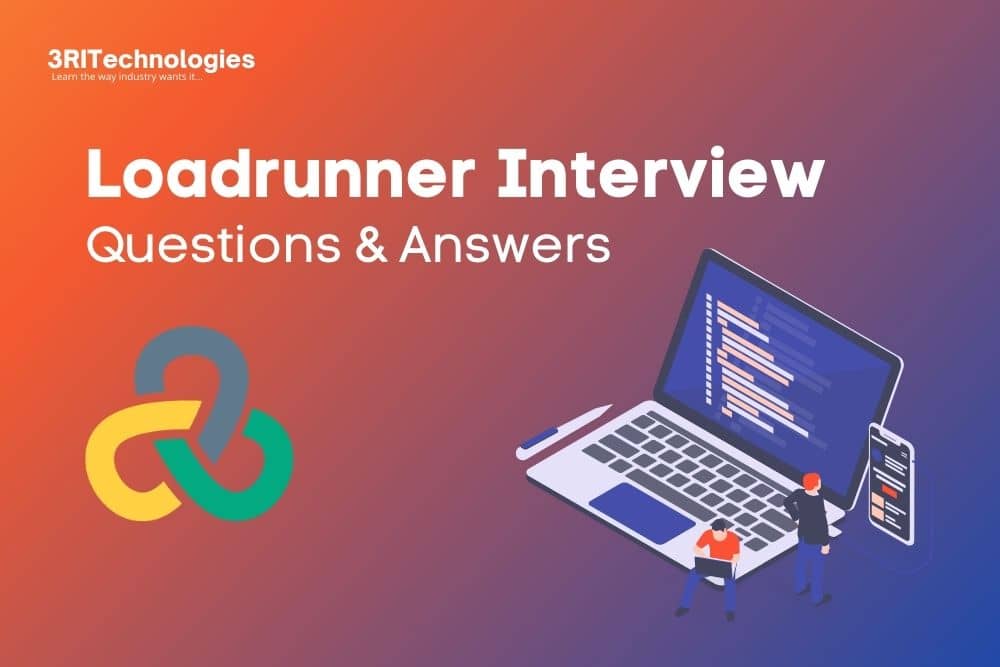Preparing for a performance testing role? Explore the most relevant LoadRunner interview questions that interviewers commonly ask—from basic LoadRunner functions interview questions to advanced performance testing interview questions LoadRunner for experienced professionals. Whether you’re aiming for a QA, SDET, or performance engineer role, this guide helps you understand the essentials. For hands-on expertise, check out our Load Runner Training program at 3RI Technologies—designed to make you job-ready with real-time project experience and expert mentorship.
Master Performance Testing: Key LoadRunner Interview Questions for Experienced Candidates
Are you a professional tester of software development tools? Do you wish to demonstrate your abilities within a company? Loadrunner is a software testing tool used to determine the output and actions under load and assist in analyzing and resolving application performance issues.
Loadrunner jobs include knowledge of several protocols, the ability to write SQL queries, perform log analysis, and oral and written communication and documentation skills, among other things.
Numerous IT industries in India and abroad provide job opportunities for various performance test engineers, automation engineers, test analysts, and automation tester. The experts created the LoadRunner interview questions and answers to help candidates secure a position on the team.
What does Loadrunner mean?
LoadRunner measures and analyses the system’s efficiency and features with extreme accuracy
When Is It Necessary to Use Loadrunner?
When load sustaining is needed for the project, and the tool/application must work under heavy loads, we use a load runner to test applications.
What Are the Benefits of Loadrunner?
● During the test, LoadRunner records the client/output servers automatically.
● Loadrunner defines where performance bottlenecks exist, such as network/client latency.
● Loadrunner keeps an eye on the network and server resources to optimize performance.
How Is a Loadrunner Controller Defined?
The controller is responsible for the scenario’s management and maintenance. You can control all virtual users from a single workstation by using the controller.
What Is the Loadrunner Application Programming Interface (API) Function?
Database users do not run client applications. Instead, the database user can access data from the server using the LoadRunner API feature.
What Is the Loadrunner Begin-transaction And How Is It Constructed?
It initiates the script’s transaction. Graphology. LR-transaction-begin (“transaction name”).

What Is a Loadrunner End Transaction and How Is It Structured?
It brings the deal to a close. Graphology. LR-transaction-at-the-end (“transaction name”, LR-AUTO).
Loadrunner Supports Which Protocols?
LoadRunner directly supports industry-standard protocols, including HTTP and ODBC. Additionally, any protocol that communicates via a Windows socket is supported.
What Types of Events Can Loadrunner Monitor?
During a test run, keep an eye out for system bottlenecks and collect and view performance data from each server or component.
How Many Users Will Loadrunner Emulate on A Single Computer?
The possibilities are endless., The system’s response determines it. Additionally, it is dependent on a variety of factors, such as the overall system configuration. If the device bottlenecks observe at the beginning or at least no Vusers, no additional users are considered unless the observed blockage has been resolved.
Want to Upskill to get ahead in your career? Check out the LoadRunner Testing in Pune.
What Are Loadrunner’s User Components?
ApplicationComponents that are used are client, database, or business application server.
The web server communicates with and through a LAN, WAN, or a www connection.
Without using www., the client, business server, and database server components are accessible through protocols such as FTP.
How Is Vuser Script Defined?
While a scenario is running, each user executes a script, referred to as the vuser script.
What Is Information Contained Inside the Vuser Script?
The vuser script contains functions for monitoring and recording the server’s output during the scenario.
How Are Transactions Defined?
The duration of a transaction is when it takes for the server to react to a task requested by the virtual user.
Where Is Rendezvous Point Located?
To emulate the server’s peak load.
When Should the Rendezvous Point Be Inserted?
When multiple users perform tasks simultaneously, insert the rendezvous point to emulate the server’s peak load.
What Is the Test Planning?
Define the performance testing criteria, including the number of simultaneous users, normal business processes, and the required response time.
Why does “Creation of a Vuser Script” mean?
“Creating a vuser script” emulates the actions taken by the virtual user during scenario execution.
How Should A Scenario Be Created?
On the host, we must install the LoadRunner controller. Then we have a list of hosts (where vuser scripts executed), a list of vuser scripts (where users executed), and a list of users performed during the scenario.
Explain an RCL (Remote Command Launcher)?
The RCL command instructs the controller to begin the host machine’s program.
How Many Varieties of Vuser Are There?
Vusers come in various types (GUI, database, RTE (terminal emulator), SAP, DCOME, PeopleSoft, Java, and Baan).
What is Gui Vuser, and what is the platform to run on?
GUI vuser is a graphical user interface application running in either Microsoft Windows or an X-Windows environment.
What Is Microsoft Windows?
WinRunner is an application that is used to run Microsoft Windows applications.
What Exactly Is X-windows?
For X-Windows applications, X-runner and VX-runner are available.
How Are Database Vuser Scripts Developed?
Development of the vuser script database is done using either the generator of the LoadRunner script (VuGen) or the script template of the LoadRunner vuser.
How Many Sections Does the Vuser Script’s Database Have?
Each written in C, a SQL call to the database, and a TSL call to the database.
How can the Basic Script be enhanced?
By adding control flow and structure, by inserting transaction and rendezvous points, and by incorporating functions
Where Should The Rendezvous Point Be Located?
Insert a rendezvous point into the script to determine the server’s peak load.
lr-rendezvous Syntax: (“rendezvous name”).
What Do The Loadrunner Controller’s Elements Do?
The title bar (name of the scenario presently working). Bar menu (selecting the various command). The toolbar. Bar of status.
Scenario Wizard – What Is It?
With the scenario wizard, we can create new scenarios.
Explain Distinction Between Sorting And Filtering?
We may filter the information display to only those that meet the defined criteria (filter box).
For instance, you can filter users to ready users. Sorting – All users in the vuser list can sort. To their user ID (1,2,3,4,5,6,7,8,9).
What Are the Host Attributes?
● Maximum host vuser number can run.
● The allocation quota for initialization.
● WinRunner configuration file location.
● The file location during runtime.
How do you determine a large number of Virtual Users a Host Can Support?
The maximum number of virtual users is configurable (available resource, LoadRunner license agreements, the needs of your scenario).
What do you mean by quota initialization?
Host capabilities that at a time are initialized by how many users.
What is the default scenario?
Instruct the user to use the configuration file of WinRunner.
Why Did We Include The Rendezvous Point During The Scenario’s Execution?
If a multiple vuser performs tasks simultaneously
Wishing to start a career as a Software Tester? Get trained by Industry Experts in Software Testing Course in Pune
When a scenario runs, what happened?
● The controller verifies the configuration details for the scenario.
● Then invoke the program you want to run on the scenario next.
● The scripts are then transformed to their related hosts, and when the users are ready, they begin execution.
What is Virtual User Graph Running?
It shows the number of users that execute the vuser script during the scenario’s execution. Included are just the running and rendez states. (the loading, ready, and pause states are not visible).
What Exactly Is a Report Viewer?
The report header and the report viewer toolbar are included in each viewer.
What Is A Report Header and What Information Does It Contain?
It outlines the general scenario and includes data such as (scenario, title, start time, end time, and duration).
How Is A Rendezvous Graph Defined?
It indicates when and how many users are released from rendezvous points.
Thus, it contributes to the transaction’s performance time.
What Are the Different Correlation Types?
Co-relationships: Manual & Automatic
Correlation by hand: Correlation is used to obtain data unique for each script run and provided by nested queries.
It’s where we establish correlation rules for automatic correlation. Again, it could be server-specific to the application. In this section, values are substituted for the data produced by these laws.
Explain load testing and why is it required?
Load testing is used to decide whether an application can handle the loads associated with many simultaneous users and transactions and determine whether it can handle peak use periods.
What is Performance Testing, Why Is It Required?
Timing data should be collected to evaluate whether system operations are performed within a timeline for all read and update transactions. The effects of multiple transactions on the timing of a single transaction should be first achieved within the single-user environment and then in a multi-user environment.
How Would You Describe the Load Testing Process?
● Planning the test is the first step. Here, we create a well-defined test plan to ensure that the load-testing scenarios we develop can achieve their objectives.
● Creating Vusers is the second step. We build Vuser scripts in this section, including individual Vusers, tasks performed by all Vusers, and tasks calculated as transactions.
● Scenario development. A scenario describes the events during a test containing a list of the devices, scripts, and Vusers active during the scenario’s execution. Using LoadRunner Controller, we build scenarios. We can create both manual and goal-oriented scenarios. In each manual scenario, we define the number of users, the load generators, and the percentage of users. We may construct a goal-oriented Web test scenario to determine the test’s goals. LoadRunner builds a situation for us immediately.
● Scenario execution: We simulate server load by instructing many users to perform tasks simultaneously. We set the scenario and plan the tests before the testing. We can run the whole scenario, each user or the group of users.
● Keep an eye on the scenario. We track scenario execution by using LoadRunner’s online runtime, transaction, computer resources, web resource, web server resource, web app server resource, network delay, firewall server resource, media resource streaming, and ERP server resources and Javan performance monitoring.
● Analysis of test results is the sixth step. LoadRunner tracks application performance with different loads during scenario execution. We evaluate the results of the application using the graphs and reports of LoadRunner.
When Should Load and Performance Testing Be Performed?
After we have completed the interface (GUI) testing, we conduct load testing. The architectures of modern systems are vast and complex. Although single-user testing focused on the functionality and user experience of a system component, application testing is concerned with the performance and reliability of the entire system. For instance, a typical application-testing scenario might involve 1000 users simultaneously logging into a system. It raises questions about the system’s response time, whether it crashes, whether it is compatible with different software applications and platforms, and whether it can support hundreds and thousands of users. It is the stage at which we conduct load and performance testing. Learn more at 3RI Technologies
What Is A Rendezvous Point?
You have rendezvous points in user scripts to model high volumes of user activities on the server. Rendezvous points recommend that users wait for several users to come at a certain point to perform a task simultaneously. For example, you can insert an appointment to instruct 100 users to simultaneously deposit cash on their accounts to emulate maximum load on the Bank Server.
What is the concept of a scenario?
A scenario is a summary of the events during the test session. An example is that a scenario specifies and controls the number of virtual users to emulate, the tasks to be performed, and the machines that run virtual emulations.
Describe The Web Vuser Script’s Recording Mode.
By recording a user conducting standard business processes on a client application, we can create a Vuser script using VuGen. VuGen generates the script by recording client-server operations. For instance, VuGen monitors web applications’ client end of the database and monitors all requests received by and to a database server. Thus, VuGen is used to monitor the server contact of the application; Build the correct function calls, and enter the function calls provided into a Vuser script.
Why Are Parameters Created?
Similar to script variables, parameters are used in code. They are used to emulate real users by varying the server’s input. Every time the script run, a different collection of data sent to the server. Improved usage model simulation allows more specific control testing; a single script can simulate several system users.
How Is Correlation Defined? How Can You Describe The Difference Between Automatic And Manual Correlation?
Correlation is used to obtain data that is unique for each script run and provided by nested queries. Thus, correlation helps prevent errors due to duplicate values and optimizes the code (avoid nested queries). Automatic correlation is a process by which rules of correlation are created. For example, the application server may be unique. Here, values are replaced for the data that these rules provide. Manual correlation involves scanning the value to be correlated and then using create a correlation to do so.
How Do You Determine Which Areas Need Correlation? Provide a Few Case Studies From Your Work?
There are two possibilities: First, we can perform a correlation scan, displaying a list of potentially correlated values. It lets us choose a correlation value. Second, two scripts can be recorded and compared. We can examine the difference file to determine which values needed correlating. A unique identifier was created for each customer; it was nothing more than an Insurance Number; it was produced automatically, sequential, and contained a single value.
Where Do You Setup Options for Automatic Correlation?
Correlation automatically from a web-based perspective can be configured in the recording options and correlation tabs. Here, we can allow correlation for the entire script and specify sending online messages or performing offline actions. We can also establish correlation rules here. Automatic database correlation can be accomplished by opening the show output window, selecting the search for correlation option, selecting the correlate query tab, and selecting the query value to correlate. If we know the particular value to be connected, we create the correlation and determine the method by which the value can create.
What Is A Web Vuser Script Function That Captures Dynamic Values?
The web reg saves param function, which saves information about dynamic data in a parameter.
When Do You Disable Login for the Virtual User Generator and When Do You Use Standard or Extended Logs?
After debugging and validating that our script is working, we can disable logging for all events except errors. When we use a script in a situation, logging is disabled automatically. When you choose Standard Log, turn off this option when the standard function and message log is sent while running a script built for debugging in wide-ranging load test scenarios. When a script is copied to a scenario, logging is disabled automatically. Option for an extended log: Select an extended log to generate an expanded log with alerts and other messages included. Disable this option in large load test scenarios. If you copy a script to a scenario, logging will be deactivated automatically. The extended log options allow us to select additional information from the extended log.
Enroll in Tosca Training Today and Learn from the Experts.
How Are Loadrunner Scripts Debugged?
VuGen includes two debugging options for Vuser scripts: Run Step by Step and breakpoints. The Debug settings options dialogue allows us to indicate the extent of the trace, which can be performed during scenario execution. The output window is used for debug information display. You may use the LR Set debug message feature to set the message class in your script manually. It is advantageous if we want to obtain debug details for a particular part of the script.
How Do You Write Lr’s User Defined Functions?
Before creating User Defined Functions, we must first create the associated external library (DLL). This library is then included in the VuGen bin directory. After we’ve added the library, we’ll assign a parameter to a user-defined feature. The following format should be used for the function: __declspec (dllexport) char* __declspec (dllexport) char* function name> (char*, char*) The following are some instances of user-defined functions: GetVersion, GetCurrentTime, and GetPltform are all user-specified functions.
What Can Runtime Settings Be Changed?
The Run Time Settings that we render are as follows: a) Pacing – It keeps track of the number of iterations. b) Log – This section contains two options: Disable Logging and Standard Log. c) Extended Think Time – Two options exist here: Replay Thinking Time and Ignore Thinking Time. d) General – We can define Vusers as a method or multithread under the general tab and whether every step is a transaction.
Where Do You Set Vuser Testing Iteration?
Configured Iterations in Runtime Settings of VuGen. Run time settings, pace tab, and set iteration number is navigation.
How Are Functional Tests Conducted Under Load?
Simultaneous execution of many users may be used to test loaded functionality. By increasing the number of Vusers, the maximum load the server can sustain is determined.
What is the process of ramp-up? How do you configure this?
This choice incrementally increased the number of Vusers/loads on the server. The initial value and a value can identify intervals. To set up Ramp, go to the ‘Scenario Scheduling Options.’
What Is the Benefit of Using A Thread to Run the Vuser?
VuGen supports multithreading. It allows the use of a generator with a more significant number of Vusers. When the Vuser runs as a process, a driver program that consumes large quantities of memory is loaded into the memory of each Vuser. Thus, it reduces the number of users supported by a single generator. When the user runs on a thread, a single driver program instance is loaded into memory for the required number of users. Each thread shares the parent driver’s memory so that more Vusers can run per generator.
How Do You Stop the Script’s Execution in The Event of An Error?
The LR abort function stops Vuser executing, instructing the Vuser to stop the Actions section, perform the User End section, and complete execution. This feature is helpful if you need to manually terminate the performance of a script due to a particular error condition. When this feature is used to stop a script, the Vuser’s status is set to “Stopped.” To make this change efficient, we must first uncheck the Runtime Settings option “Continue on error.”
Conclusion
We hope that the Above list of Load Runner interview questions helps you obtain the desired job profile.




